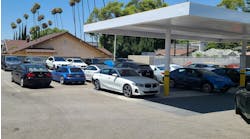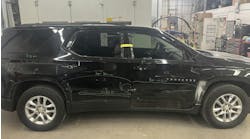It's time to revisit the OEM vs. aftermarket parts debate
There are serious reasons why shops shouldn't use certain reconditioned parts. In this case, manufacturers don't always allow bumper reinforcements to be repaired. Often, these reinforcements are made of high-strength steel (HSS) or ultra high-strength steel (UHSS). They're typically reconditioned with heat and welding, which, as you should know, can wreak havoc on these materials. The result can be a bumper that no longer protects vehicle occupants as it was intended.
This past October, a similar issue was raised by a shop owner who complained to Aaron Schulenburg, executive director of the Society of Collision Repair Specialists (SCRS), that one of his DRP coordinators specified an aftermarket core support be used to repair a 2007 Toyota Corolla. Aftermarket core supports, like reconditioned bumper reinforcements, may not provide the same functionality as OEM versions. These aftermarket parts may not use HSS and UHSS the same ways as OEM versions, meaning their use could present a significant safety issue.
Schulenburg contacted me (I'm on the SCRS Education and Training Committee) and asked me to contact the shop owner to look into the matter. My investigation was on.I spoke with Joe Di Donato, the lead trainer from Toyota University, who informed me the OEM core support is made from HSS. I asked the shop to order me the same aftermarket part the carrier had specified, and I purchased a new OEM version, which cost $300 more.
I also decided to go beyond this case to look at various popular aftermarket and OEM parts to see how much they differed in material makeup and design, and how this could impact the safety and well-being of your customers and shop.For my investigation, I purchased eight aftermarket parts: two core supports, four bumper reinforcements, one bumper bracket and one bumper absorber. I chose these parts based on my experience with and knowledge of them from I-CAR classes I teach. For example, magnesium core supports for the Ford F-150 are discussed in WCA 01, and the UHSS front bumper reinforcement for the Toyota Corolla are discussed in POP 01.
Examination by the numbers
First, look at the front bumper reinforcement on a 2009 Toyota Corolla. This reinforcement is part of the vehicle structure and air bag and energy absorption systems.
1. See Fig. 1. Note the aftermarket reinforcement has a rough texture compared to the OEM.
2. See Fig. 2. Note the damage to the bottom of the aftermarket bumper reinforcement (top image in Fig. 2). If this part was constructed of the same UHSS as the OEM version, it would take a tremendous amount of energy to damage it this way. Based on this, the steel used for the aftermarket version is probably mild steel.
3. Look for the difference in size of the mounting holes in Fig. 3. The top image is the OEM part, and the lower one is the aftermarket version.
4. Refer to Fig. 4. I used a standard 18T, general-purpose, hacksaw blade on the aftermarket bumper reinforcement (bottom of Fig. 4). Notice how much I cut into it after only five seconds of cutting. Then I changed to the super-duty extrication blade. I was only able to scratch the surface of the OEM reinforcement (top of Fig. 4).I performed the same demonstration at NACE in 2009. There, I actually cut right through the aftermarket part but was able to cut only about a half section on the OEM. This is a crude test, but it proves the aftermarket bumper reinforcement was made from mild steel because that's the only way I could cut through it.
5. The next parts I compared were bumper reinforcements for a Toyota Prius (see Fig. 5). The aftermarket bumper reinforcement (top) was bent to form its shape, so the reinforcement has two large bumps and two large craters. Based on its construction, the aftermarket reinforcement won't channel or absorb impact energy the same way the OEM does. The integrity of the SRS and the passenger compartment could be compromised.
6. Look at the front bumper reinforcements for a Honda Civic in Figs. 6 and 7. Note how the shape of the aftermarket reinforcement (bottom) differs markedly compared to the OEM. Would the aftermarket part perform the same as the OEM? You need to know this answer.7. Figs. 9 and 10 show the front bumper brackets for a Nissan Xterra. The aftermarket part appears identical to the OEM but is actually 1.4 mm thinner. Being thinner and lighter, will it behave the same as the OEM part in a collision? I don't think so. Nissan would have made this part thinner if it believed doing so would offer the same functionality while saving material costs.
8. Next, I examined the core support from the 2007 Corolla. The aftermarket version appeared similar but a closer look revealed the bends weren't as sharp as those in the OEM. Also, a through-hole was used instead of a threaded insert.One other significant problem I discovered was the metal on the aftermarket part was different from the OEM. I determined this by performing a hardness test on two samples taken from the core support. The aftermarket part had a reading on the A scale of 20, while the OEM had a reading of 30. Admittedly, a tensile strength test (PSI) would've produced a better metal analysis. Still, this test demonstrated a significant difference between the steel used in each part.
9. Next, I compared core supports used in 2004 - 2008 Ford F-150s. The OEM part is made from magnesium, and the aftermarket part is constructed from aluminum (see Fig. 11). According to Ford engineers, magnesium is 38 percent stronger than aluminum. Ford considers the core support a structural part. As such, what happens in a frontal impact when the aftermarket part is substituted for the OEM?Making your decision
Another point I want to stress is none of the parts I looked at are CAPA certified. Currently, CAPA doesn't certify bumper absorbers, reinforcements and brackets or core supports because they're considered structural.
A number of insurance companies require their DRP shops to use these parts. Note these same companies required their DRP shops to sign agreements stating the shop won't hold them liable for repair decisions. If one of these non-certified parts is used in a repair and someone gets seriously hurt or dies, the shop is left holding the liability bag.Energy and design basics
To appreciate how high-strength steel (HSS) and ultra high-strength steel (UHSS) function in a bumper, it's necessary to better understand how metals, structure and energy movement work together during a collision.
There are two types of energy movement during a collision: absorption and transfer. Energy absorption occurs at the point of the collision and is dissipated by the deformation of the parts. As the parts start to deform, energy is reduced as it travels from the point of the collision to the opposite side of the vehicle.
Energy transfer moves energy away from the point of impact and toward other areas of the car. Energy transfer that occurs on side and rollover impacts is achieved by making certain parts stronger. These parts include the front windshield post reinforcement, B pillar reinforcement, door intrusion beams, rocker panel reinforcements, floor reinforcement, A pillar reinforcements and roof reinforcements. As you should know, manufacturers incorporate HSS and UHSS in these parts to make them stronger. They engineer these parts to react in a specific way to protect passengers during a collision.
Bumper reinforcements are made from HSS and UHSS for the same reason. They're a perfect example of how auto manufacturers use higher percentages of HSS and UHSS to increase the safety of motorists. It's our job to know how to replace or repair a vehicle so it can offer the same protection as it was intended. That means using parts of the same design, thickness and metal hardness as the original.
Diamond Standard Brand, which makes absorbers, reinforcements and brackets, tests all their reinforcements (same family of parts) with the same testing company OEMs use – MGA Research Corp. Diamond Standard Brand reinforcements are manufactured using the same materials and processes employed by the OEMs.
Visit www.diamondstandardparts.com and view the testing of the front bumper reinforcement. Pay particular attention to the end of the reinforcement, and watch what happens to the aftermarket reinforcement. If you're still thinking about using an untested reinforcement, this video could change your mind quickly.
Diamond Standard also uses the same high-impact polypropylene foam OEMs use in the manufacturing process of bumper absorbers. I haven't compared their bumper brackets, but a company representative told me it uses the same materials as the OEM and uses special jigs for measuring the accurate placement of holes.


